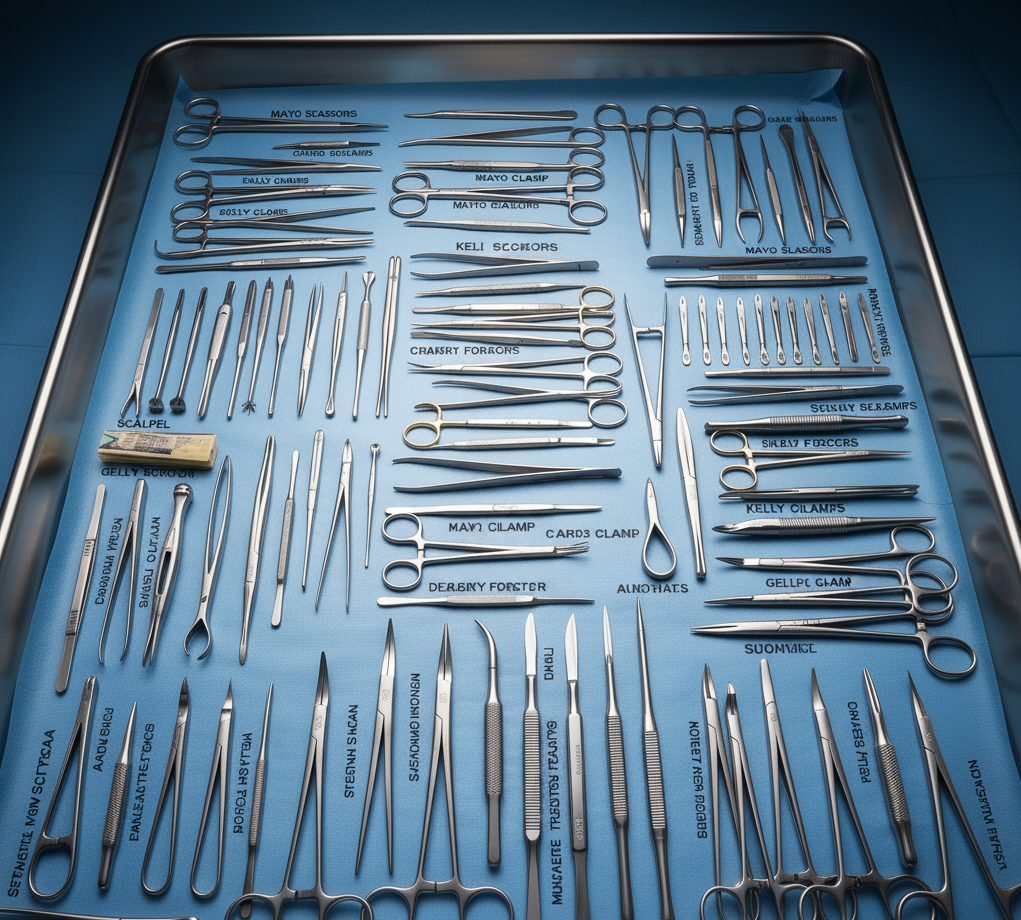Introduction
Surgical procedures depend on accuracy, skill, and the right tools. Surgeons, nurses, and students must be familiar with a wide range of surgical instruments. But remembering the names of surgical instruments with pictures can be challenging, especially since many instruments look alike but serve very different functions.
That is why having a structured guide that combines names, descriptions, and images is one of the best ways to learn. In this article, we will explore the most common surgical instruments, organize them by category, and provide their names with visual explanations. This helps students, healthcare professionals, and even patients understand the role of each instrument inside the operating room.
Why Learning the Names of Surgical Instruments with Pictures Matters
- For Students – Medical and nursing students must recognize instruments in exams and practical training.
- For Surgeons – Quick identification ensures efficiency and safety in the operating room.
- For Nurses & Technicians – Sterile processing staff use names and pictures to correctly sort, clean, and prepare instruments.
- For Hospitals – Standardization across teams reduces confusion and errors.
- For Exporters & Manufacturers – Companies like Professional Enterprises create catalogs with names and images for buyers worldwide.
Categories and Names of Surgical Instruments with Pictures
Surgical instruments are divided into eight main categories. Each has multiple instruments, and pictures help make identification easier.
1. Cutting and Dissecting Instruments
Used to cut tissue, skin, or bone.
- Scalpel – Small, sharp blade for making incisions.
- Mayo Scissors – Heavy scissors for cutting thick tissue.
- Metzenbaum Scissors – Fine scissors for delicate tissue.
- Osteotome – Chisel-like tool for cutting bone.
Picture Reference: A tray with scalpel, scissors, and osteotome side by side.
2. Grasping and Holding Instruments
Used to hold tissue, organs, or surgical materials.
- Forceps – Tweezer-like tool for grasping tissue.
- Allis Forceps – With teeth, for holding tissue firmly.
- Needle Holder – For holding needles during suturing.
- Towel Clamp – For securing drapes and towels.
Picture Reference: Forceps and needle holders arranged neatly.
3. Clamping and Occluding Instruments
Used to stop bleeding or clamp vessels.
- Hemostatic Forceps (Hemostat) – Controls bleeding by clamping blood vessels.
- Kelly Forceps – Larger clamp for medium vessels.
- Mosquito Clamp – Small, precise clamp for tiny vessels.
- Vascular Clamp – For delicate vascular surgery.
Picture Reference: Hemostats and mosquito clamps side by side.
4. Retracting and Exposing Instruments
Used to pull back tissue and expose the surgical site.
- Senn Retractor – Small, handheld retractor.
- Weitlaner Retractor – Self-retaining retractor with prongs.
- Balfour Retractor – Large abdominal retractor.
- Richardson Retractor – Handheld with flat blade.
Picture Reference: Different retractors laid out on a tray.
5. Suturing and Stapling Instruments
Used to close wounds and surgical incisions.
- Needle Driver – Holds needles for suturing.
- Skin Stapler – For quick closure of skin incisions.
- Ligature Carrier – Used in deep cavities for placing sutures.
Picture Reference: Needle driver and stapler displayed clearly.
6. Suction and Aspirating Instruments
Used to remove blood, fluids, and debris.
- Yankauer Suction Tip – Rigid tube for oral suction.
- Poole Suction – For abdominal procedures.
- Frazier Suction – Thin tube for neurosurgery and ENT.
Picture Reference: Yankauer and Poole suction tips side by side.
Dilating and Probing Instruments
Used to explore or enlarge openings.
- Uterine Dilator – For gynecological procedures.
- Lacrimal Probe – For eye and tear duct exploration.
- Grooved Director – For guiding other instruments.
Picture Reference: Dilators of different sizes shown together.
Specialty Surgical Instruments
Used in advanced or specialty-specific fields.
- Neurosurgical Drill – For cranial procedures.
- Ophthalmic Scissors – For eye surgery.
- Orthopedic Saw – For bone cutting.
- ENT Speculum – For ear, nose, and throat examinations.
Picture Reference: Small ophthalmic instruments next to larger orthopedic tools.
How Many Surgical Instruments Exist?
Globally, there are over 10,000 different surgical instruments across specialties. Each has variations in size, shape, and function. While basic instruments like scalpels and forceps are found in almost every procedure, specialty instruments expand the total number significantly.
Best Way to Learn Surgical Instrument Names with Pictures
- Use Differentiating Surgical Instruments Books – These provide structured visual learning.
- Practice in Labs – Compare real instruments with images.
- Flashcards and Apps – Many apps offer surgical instrument quizzes with pictures.
- Group Study – Learning with peers helps memorization.
- Manufacturer Catalogs – Exporters and suppliers publish detailed catalogs with names and photos.
FAQs
1. Why are pictures important when learning surgical instruments?
Pictures help differentiate similar-looking instruments and improve recognition.
2. How many surgical instruments are there with names?
There are 10,000+ instruments, though only 100–200 are commonly used in general surgery.
3. What is the easiest way to memorize surgical instruments?
Using books and flashcards with names and pictures is the most effective method.
4. Do hospitals use the same set of instruments?
Basic instruments are standard, but specialty instruments vary by hospital and department.
5. Can I find free resources for surgical instrument pictures?
Yes, many universities, hospitals, and manufacturers publish free visual guides online.
Conclusion
Learning the names of surgical instruments with pictures is essential for students, surgeons, nurses, and technicians. By combining visuals with explanations, recognition becomes much easier. While there are thousands of instruments globally, understanding the core categories—cutting, clamping, grasping, retracting, suturing, suctioning, dilating, and specialty tools—provides a strong foundation.
At Professional Enterprises, we support medical professionals by supplying high-quality surgical instruments with clear product codes and visual catalogs, ensuring that learning and identification are simple and accurate.

